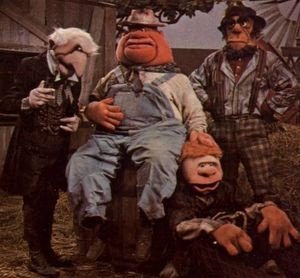The Muppet Musicians of Bremen
In early 1972, Jim Henson filmed another Muppet special in Toronto, The Muppet Musicians of Bremen, the third and final in the Tales from Muppetland series and in some ways the least of the “trilogy,” and similarly based on a Grimm’s fairy tale, albeit an overall lesser-known one. That isn’t to say that the special–which aired on April 26, 1972–doesn’t have its strong points. I actually remember enjoying it a great deal as a child, however, when I rewatched it for this site, I noticed how thin the story was in comparison to the previous outings. Whereas Hey Cinderella! and The Frog Prince seem to effortlessly expand their tales to fit the nearly-hour-long format, Bremen often feels like it’s stretching to fill time.
As with most of these pre-Muppet-Show productions, however, it does make significant contributions to Muppet history, albeit perhaps not as much as something like The Great Santa Claus Switch. It features the first set of Muppet rats, although their overall look would shift over the years, and the debut of the Muppet chickens–an even more exciting discovery, as they look pretty much exactly as they will when Gonzo will date his poultry love, Camilla. The only real bit of dissonance is that they talk rather than simply cluck, and one of them is performed by Jerry Juhl (who wrote the script, as per usual), sounding pretty much exactly like Taminella. It’s a bit disconcerting to hear her voice coming out of a chicken, but then again, she did turn into a bird at the end of The Frog Prince!
Even more importantly, from a backstage perspective, this was the first Muppet production to feature the work of Bonnie Erickson, whose designs were less abstract than Don Sahlin’s and more cartoonishly exaggerated. Whereas he would add a few simple features to a flatter face on soft fabric, she used thicker polyurethane to create a molded 3-dimensional face that was also more malleable, such as Miss Piggy’s would later be. This special features 4 full-body Muppets portraying human hillbillies that look almost disarmingly real and simultaneously cartoony at the same time, creating almost an uncanny valley effect. This special also marks when they started building Muppets with the “flocking” process, which is often used in jewelry box interiors and creates a fuzzy look that allowed the Muppets to both look softer and be lit better than ever before.
Bremen is also rather unique in multiple ways. For one, it’s the rare Muppet show to not feature a single actual human at any point on screen. The closest it comes to it are the full-body hillbillies, but again, their faces are entirely hidden under foam heads and so, like Big Bird, Sweetums, Thog, Splurge, etc., they count as puppets. Secondly, other than the chickens, the only really recognizable Muppet to appear is Kermit, and besides acting as narrator and sharing a brief scene with the main protagonist–a donkey called Leroy–he only has a very small role. He is essentially there to provide some recognizable continuity with the Muppet brand for audiences to connect with but he doesn’t stay for long. The rooster, T.R, dog, Rover Joe, and cat, Catgut, would technically make a few scattered, minor, background appearances later but would never again be featured this prominently and poor Leroy would never be seen or heard from again!
This might also be because, in a genuine departure from the norm, 3 of the 4 animal heroes of the story–Leroy, Rover Joe, and Catgut–aren’t voiced by Muppet regulars but by Toronto-based actors! Nick Nichols, a voice actor, played Leroy, Francois Klanfer, a theatre actor, played Rover Joe, and Phyllis Marshall, a jazz singer and actress, provided Catgut’s distinctively scratchy, bluesy voice, which sounds more than a little bit like a countryfied Carol Channing. The entire special is actually extremely American-countryfied, the action of the original fairy tale having been moved from Germany to Louisiana, and the catchy, very-country score having been written not by a Muppet regular like Joe Raposo but the man who wrote the music to Barney Miller, Jack Elliott.
The humor is also far more restrained than in previous specials, with basically no anachronistic or self-aware gags or even much of a distinctly Muppey twist a la the specifics of Tammy’s curse on Princess Melora in The Frog Prince. There are a few wry chuckles (as well as a fairly unfunny recurring joke in which T.R. continually changes what his initials stand for, based on the particular circumstances of any given situation; when he’s tired, he claims to be “Tuckered Rooster”; when he first runs away, he’s “Travelling Rooster”; when he’s scared, he’s “Terrified Rooster”; ummmm, haha?), but nothing to match the fractured fairy tale free-for-all of Hey Cinderella!, all of which gives the special a significantly different, more restrained feel than the usual Muppet fare.
It is, however, very interesting for numerous reasons. The puppetry is as impressive as ever, particularly Leroy, who may not actually be a life-size donkey but almost feels like it, scale-wise, and who spends much of the show trotting down dirt roads, all four legs realistically clopping along as he pulls an old cart behind him. And it’s a real thrill to see all of the animals finally assembled and playing their instruments together. Additionally, it’s very cool to see a Muppet (or any children’s story) story that revolves around senior citizen animals, all of whom escape their evil owners one by one and join one another to become an oddball family of traveling musicians. When Rover Joe initially cries out, “I’m old, I’m beat up, I’m wored [sic] away, and I’m throwed out,” T.R. cuts him off by saying, “That don’t matter none. We’re all old!”
In its structure of a protagonist seeking a home while traveling down a road, picking up 3 friends along the way, and each time singing a slightly revised version of the same song (in this case about being a traveling musician), it’s extremely reminiscent of The Wizard of Oz, as well as a foreshadowing of the basic structure of The Muppet Movie, another friends-meeting-on-a-road-trip story and also one specifically about animals who dream of becoming entertainers, spreading joy and song wherever they go. And the special is at its best in each character’s introduction, as each tells his or her story of woe before being welcomed into their little band. I particularly love Catgut’s flashback in which she tells the rats living in her master’s kitchen that she’s tired of chasing them after all these years and is officially calling a truce, launching into a wonderfully jazzy number that hasn’t left my head since I saw it.
The major problem with the show, however, is that, once everyone is finally assembled, it doesn’t really have much more plot to tell. That very night, all 4 of them, tired and hungry, happen upon a house that Leroy naively hopes is home to a lovely family for whom they can play music and who will repay them with food and a warm hearth for the night. In actuality, it’s a thieves’ hideout, and those thieves just happen to be each of these animals’ former owners. However, when Leroy goes up to the house to check it out, he only sees their silhouettes in the window and believes that he’s seeing the family he’d dreamed of, sitting down to dinner.
When he returns to tell his friends he was right, they each insist on corroborating his story, one by one. Each one walks up to the house, we cut to a scene inside the house in which the thieves are arguing with each other, and then cut back to that animal misinterpreting what he or she is seeing. It’s a long, drawn-out sequence that could have been accomplished by the others simply believing Leroy’s story (as inaccurate as it was) other than the fact that the running time otherwise would have been too short. And while it’s an initially amusing conceit, it leads to diminishing returns by the 4th time we’ve gone through what is essentially a beat-by-beat repeat of the same joke. With that said, it does lead to a great moment, when the animals sing a reprise of their song about the “lovely family” they imagine, and we then see each of the crooks ironically appear in the garb of one of these supposed family members, with a bonnet on the “mother” and “pretty bows” in the “daughter”‘s hair.
Then we have the big confrontation, in which the animals scare their horrible former owners out of their minds, the thieves mistaking them for “swamp ghosts” and running away into the night. But while the thieves never realize what really happened, neither do the animals. They just think that they chased away a group of bad guys (who they don’t even recognize in the dark) who had attacked their poor, lovely family, then deciding to remain in the house and guard it for “them” until “they” return. And while their mistake is amusing to a degree, it also diminishes their heroism, because they close out the story remaining rather foolish and deluded, with no clue as to their real accomplishment. The climactic sequence also goes on far longer than it needs to and is extremely repetitive and largely obscured by darkness. The jaunty score the animals are playing all the while is the only thing that keeps it from getting too boring.
All in all, not a bad Muppet special. More often than not, it remains entertaining, but it lacks the narrative cleverness and ingenuity of the previous Tales from Muppetland, as well as their sharper senses of humor, ultimately keeping it from being a true Muppet classic, although it at least demonstrates the heart, generosity, and open-hearted philosophy of Henson’s better work. And you can watch it at the following links: Part 1, Part 2, Part 3, Part 4, Part 5, and Part 6.
I hope you have a wonderful New Year’s Eve, and see you back next week in 2016 (unless I happen to finish my The Muppets episode 10 review over the next day or two, in which case that’ll be up sooner!), when we get to some guest appearances that Sesame Street characters made on other shows before then launching into Season 4!




